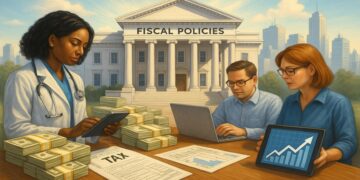The Role of Fiscal Policy in the Post-Pandemic Economic Recovery

Impact of Fiscal Policy on Economic Resilience
The economic landscape has drastically changed in the aftermath of the pandemic, prompting governments to reconsider their approaches. One of the key tools at their disposal is fiscal policy—a crucial element for strengthening economic resilience and recovery. Understanding how fiscal policy can spur growth is vital for both policymakers and the public.
Fiscal policy refers to government spending and taxation decisions that influence a nation’s economic activity. Through carefully crafted fiscal measures, governments can create significant outcomes that resonate across various sectors of the economy.
- Job creation through targeted spending: For instance, investing in renewable energy projects not only safeguards jobs in traditional energy sectors but also fosters new opportunities in sustainable industries.
- Support for businesses facing financial distress: During the pandemic, numerous small enterprises struggled to keep their doors open. Financial relief packages and grants can provide crucial lifelines, helping to maintain employment levels and ensuring community stability.
- Investment in infrastructure to stimulate growth: Upgrading highways, bridges, and public transportation systems can create jobs and improve economic efficiency, making it easier for communities to thrive.
As the United States navigates its recovery, several fiscal measures have been proposed and enacted to stabilize the economy. These include:
- Increased stimulus payments to individuals: In 2020 and 2021, direct payments were issued to help Americans manage living expenses, which in turn helped stimulate consumer spending and economic activity.
- Expanded unemployment benefits for displaced workers: Enhanced benefits were crucial in assisting millions who lost jobs during the crisis, allowing them to support their families and contribute to local economies while they searched for new opportunities.
- Incentives for businesses to hire and retain employees: Programs such as the Paycheck Protection Program provided forgivable loans to help keep businesses afloat and retain their workforce, making a difference in many communities across the nation.
Data indicates that timely and effective fiscal policy plays a decisive role in shaping economic recovery trajectories. According to the Congressional Budget Office, countries that implemented aggressive fiscal measures saw a quicker rebound in GDP, emphasizing the importance of these tools. As businesses reopen and consumer confidence begins to grow, continued support through thoughtful fiscal policy may very well guide the United States toward a more resilient economic future.
As we delve deeper into the role of fiscal policy, it becomes clear that understanding its impact on everyday life and the overall economy is essential. The design and execution of these fiscal strategies will determine how well America overcomes lingering challenges and paves the way for sustained growth. Stay tuned to explore how these strategies can pave the way for a more robust economic future.
Fiscal Policy as a Catalyst for Economic Growth
In the wake of the pandemic, the significance of fiscal policy has never been more pronounced. Governments across the globe, particularly in the United States, have turned to fiscal measures to counteract the economic fallout and stimulate growth. By employing strategies that promote immediate relief and long-term sustainability, fiscal policy serves as a catalyst for revitalizing the economy. Exploring how these measures shape recovery not only informs public understanding but also highlights their broader implications for economic stability.
One of the most effective ways fiscal policy can contribute to recovery is through targeted government spending. Investments in essential public services and infrastructure projects are paramount in creating jobs and enhancing economic efficiency. For example, the proposed rebuilding of highways and public transit systems can facilitate commerce and improve access to jobs, thereby stimulating local economies. These large-scale projects not only provide immediate employment opportunities but also lay the groundwork for future economic growth.
Moreover, fiscal policy directly influences the disposable income of households. Tax cuts and direct payments to individuals can significantly boost consumer spending, which accounts for a substantial portion of the U.S. economy. Following the pandemic, the additional stimulus payments allowed households to meet their basic needs, contributing to a shared economic resurgence. Such financial support builds a sense of security, encouraging consumers to spend confidently, which in turn fuels business revenue and stimulates the overall economic cycle.
Furthermore, it is essential to recognize the importance of fiscal policies that focus on small business support. Small businesses are the backbone of the American economy, employing nearly half of the private workforce. During the pandemic, many small firms faced unprecedented challenges that threatened their survival. This is where fiscal intervention proved crucial, with programs such as the Paycheck Protection Program (PPP) providing forgivable loans that helped preserve millions of jobs. As these businesses stabilize, their recovery becomes integral to the nation’s economic health.
- Investment in workforce development: Fiscal policy can be tailored to include training programs that equip unemployed individuals with skills suited for emerging job markets, thus addressing the mismatch between available jobs and workforce skills.
- Incentives for innovation: Allocating funds for research and development encourages businesses to invest in new technologies, facilitating advancements that may drive economic growth for years to come.
- Support for essential sectors: Sectors such as healthcare and education have undergone significant strain; targeted funding can help alleviate pressure and ensure consistent quality of service.
The ongoing assessment of fiscal policy effectiveness is critical in understanding its impact on recovery trajectories. As policymakers navigate the complexities of the post-pandemic landscape, utilizing evidence-based strategies grounded in fiscal policy will be essential for fostering a resilient economy. The interplay of these measures is not merely academic; it profoundly affects everyday lives and the collective future of the nation. The challenge remains: crafting fiscal strategies that are not only responsive to current needs but also forward-thinking to address unforeseen challenges ahead.
The Long-Term Implications of Fiscal Policy
As the dust begins to settle from the immediate impacts of the pandemic, the role of fiscal policy goes beyond short-term relief and enters the realm of long-term economic stability and resilience. The decisions made today regarding fiscal measures will not only shape recovery strategies but also set the trajectory for future economic prosperity. It raises the question of whether there exists a fine balance between necessary government spending and the implications of increasing national debt.
One critical aspect of post-pandemic fiscal policy is its ability to address income inequality. The pandemic disproportionately affected lower-income communities, exacerbating existing disparities. To combat this, fiscal measures can be strategically designed to uplift these populations. For instance, targeted tax credits or increased funding for social safety nets can provide immediate relief while also fostering a more equitable economic environment. Through these policies, the government can encourage equal access to opportunities such as education and workforce training programs, ensuring a more balanced recovery.
In addition, the alignment of fiscal policy with environmental sustainability has gained traction in recent discussions. Recognizing that the future of economic growth must align with climate goals, leaders are advocating for fiscal strategies that support a transition toward green technologies and sustainable practices. For instance, funding for renewable energy initiatives not only creates job opportunities but positions the country as a leader in the global green economy. The Biden administration’s emphasis on infrastructure spending includes significant investments in renewable energy projects, which could potentially lead to millions of jobs in sustainable sectors while fighting climate change.
Moreover, the importance of fiscal accountability cannot be overstated. As governments increase spending to facilitate recovery, ensuring responsibly allocated funds becomes essential. Reports in various economic journals indicate the necessity of rigorous oversight mechanisms designed to track the efficacy of fiscal policies and prevent wasteful spending. The call for transparency against a backdrop of increased borrowing speaks to a broader demand for government accountability, fostering trust among citizens in the recovery process.
- Support for research and education: Investments made in education not only prepare the workforce for future challenges but also drive innovation critical for economic growth.
- Public health funding: Given the pandemic’s origins, increased fiscal allocations towards public health systems will bolster readiness for future crises, directly impacting economic stability.
- Infrastructure resilience: Strengthening public infrastructure against potential climate-related events can mitigate future economic shocks and maintain continuous growth.
Understanding the intricate relationship between fiscal policy and economic recovery requires nuanced perspectives on policy-making. By recognizing the potential challenges of higher debt levels against the benefits of strategic investments, policymakers are tasked with crafting solutions that benefit not just the present but also safeguard the future economy. As ongoing debates center on various fiscal measures, their lasting consequences will resonate for generations, marking a transformative era in American economic policy. The implementation of these fiscal strategies is not only critical for recovery but serves as a beacon of how governments can reshape their economies in the face of adversity.
Embracing a New Economic Paradigm
The pivotal role of fiscal policy in the post-pandemic economic recovery is becoming increasingly clear. As governments around the world, especially in the United States, navigate this complex landscape, the strategies implemented today will lay the groundwork for a resilient economic future. Fiscal measures designed to promote growth, equity, and sustainability not only address the immediate scars left by the pandemic but also challenge us to rethink our long-term economic aspirations.
In a nation grappling with heightened income inequality, the urgency of targeting assistance towards marginalized communities cannot be overstated. Thoughtfully crafted tax incentives and enhanced social safety nets can bolster consumer confidence while fostering inclusivity. Furthermore, an unwavering commitment to environmental sustainability represents an opportunity to not only tackle climate challenges but also drive innovation and job creation in emerging sectors.
However, the success of such ambitious fiscal policies hinges on maintaining transparency and accountability. As public trust becomes crucial in the recovery process, establishing robust oversight mechanisms ensures that federal funds are utilized effectively and ethically. This accountability will reinforce civic engagement and provide a valuable foundation for future economic strategies.
Ultimately, the post-pandemic recovery serves as a crucial turning point, challenging policymakers to embrace a holistic view of fiscal policy that encompasses economic, social, and environmental dimensions. By combining immediate recovery efforts with long-term strategic investments, the United States has the potential to foster a more resilient and vibrant economy, setting the stage for generations to come. The decisions made today will indeed echo in the hallways of our economic landscape for years ahead, proving that effective fiscal policy is not just a tool for recovery but a blueprint for progress.

James Carter is a financial writer and consultant with expertise in economics, personal finance, and investment strategies. With years of experience helping individuals and businesses navigate complex financial decisions, James provides practical insights and analysis. His goal is to empower readers with the knowledge they need to achieve financial success.





